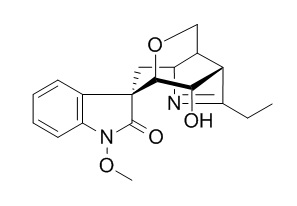Humantenidine
Standard reference
Inquire / Order:
manager@chemfaces.com
Technical Inquiries:
service@chemfaces.com
Tel:
+86-27-84237783
Fax:
+86-27-84254680
Address:
1 Building, No. 83, CheCheng Rd., Wuhan Economic and Technological Development Zone, Wuhan, Hubei 430056, PRC
Providing storage is as stated on the product vial and the vial is kept tightly sealed, the product can be stored for up to
24 months(2-8C).
Wherever possible, you should prepare and use solutions on the same day. However, if you need to make up stock solutions in advance, we recommend that you store the solution as aliquots in tightly sealed vials at -20C. Generally, these will be useable for up to two weeks. Before use, and prior to opening the vial we recommend that you allow your product to equilibrate to room temperature for at least 1 hour.
Need more advice on solubility, usage and handling? Please email to: service@chemfaces.com
The packaging of the product may have turned upside down during transportation, resulting in the natural compounds adhering to the neck or cap of the vial. take the vial out of its packaging and gently shake to let the compounds fall to the bottom of the vial. for liquid products, centrifuge at 200-500 RPM to gather the liquid at the bottom of the vial. try to avoid loss or contamination during handling.
Food Sci Biotechnol.2023, 32(9):1215-1223.
Journal of Chromatography A2020, 460942
Front. Pharmacol.2022, 901563.
J Nat Prod.2023, 86(2):264-275.
Anal Bioanal Chem. 2016, 408(15)
Biol Pharm Bull.2020, 43(10):1534-1541.
Dis Markers.2022, 2022:2380879.
BMC Complement Altern Med.2018, 18(1):221
J Ethnopharmacol.2017, 198:205-213
Anal Bioanal Chem. 2025, 417(17):3879-3892.
Related and Featured Products
J Nat Prod. 1987 Mar-Apr;50(2):195-8.
Cytotoxic steroids of Gelsemium sempervirens.[Pubmed:
3655795]
METHODS AND RESULTS:
A new pregnane derivative, 12 beta-hydroxy-5 alpha-pregn-16-ene-3,20-dione, along with the known derivative 12 beta-hydroxy-pregna-4,16-diene-3,20-dione have been isolated from a MeOH extract of the stem of Gelsemium sempervirens and found to be the principal cytotoxic entities. The 13C-nmr spectra of both compounds were assigned by comparison with other pregnane analogs thereby allowing confirmation of the stereochemistry at C-5 in compound. Heteronuclear 2D correlation and selective INEPT experiments indicated the need to revise a number of 13C-nmr assignments of pregn-4,16-dien-3,20-dione.
CONCLUSIONS:
Nine indole alkaloids, gelsemine, gelsevirine, 21-oxogelsemine, gelsedine, 14 beta-hydroxygelsedine, gelsenicine, Humantenidine, humantenirine, and koumidine were found to be inactive in the KB and P-388 cytotoxicity test systems.
J Sep Sci. 2014 Feb;37(3):308-13.
Ultrasound/microwave-assisted extraction and comparative analysis of bioactive/toxic indole alkaloids in different medicinal parts of Gelsemium elegans Benth by ultra-high performance liquid chromatography with MS/MS.[Pubmed:
24375943 ]
Indole alkaloids are the main bioactive/toxic components in Gelsemium elegans Benth.
METHODS AND RESULTS:
To determine the distribution and contents of indole alkaloids in its different medicinal parts, a novel and rapid method using ultra-high performance LC (UPLC) with MS/MS has been established and validated with an optimized ultrasound/microwave-assisted extraction method. Four constituents, namely, Humantenidine, humantenmine, gelsemine, and koumine, were simultaneously determined in 6 min. Chromatographic separation was achieved on an ultra-high performance LC BEH C18 column with a gradient mobile phase consisting of methanol and water (containing 0.1% formic acid both in methanol and water) at a flow rate of 0.3 mL/min. The detection was performed on a triple quadrupole electrospray MS/MS by positive ion multiple-reaction monitoring mode. All the analytes showed good linearity (r ≥ 0.9934) within a concentration range from 0.1-25 μg/mL with a LOQ of 25-50 ng/mL. The overall intra- and intervariations of four components were <4.7% with an accuracy of 97.3-101.3%.
CONCLUSIONS:
The analysis results showed that there were remarkable differences in the distribution and contents of four chemical markers in the roots, stems, and leaves of G. elegans Benth. The findings can provide necessary and meaningful information for the rational utilization of its resources.



